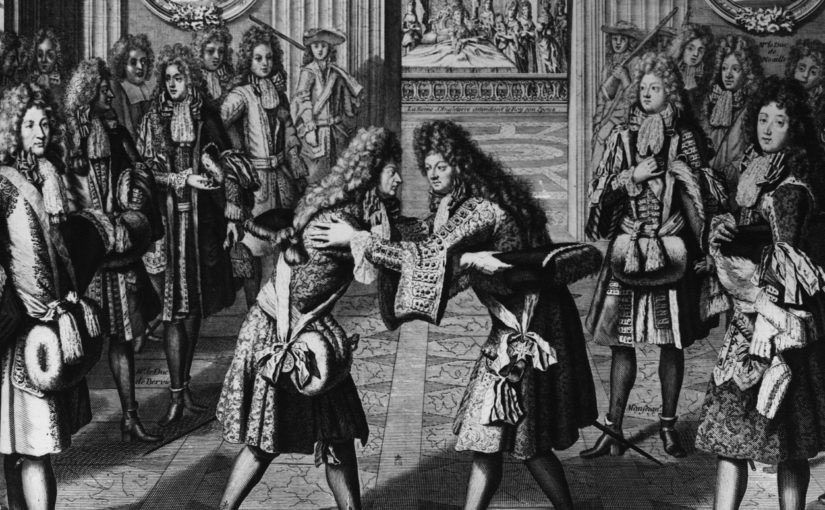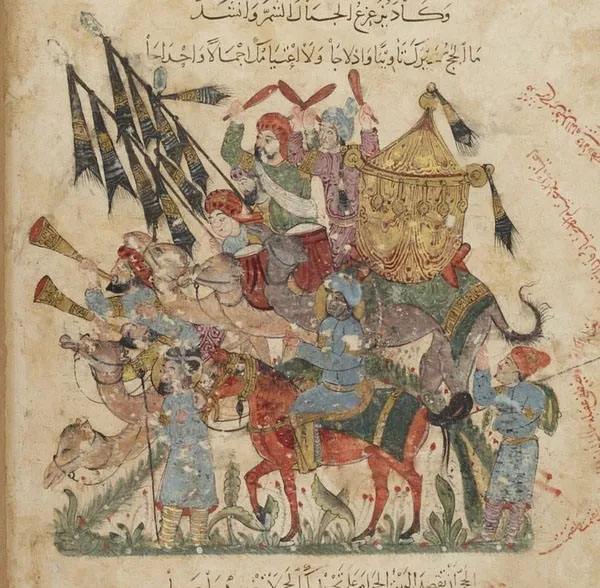 The United Religious, Military and Masonic Orders of the Temple and of St John of Jerusalem, Palestine, Rhodes and Malta in England and Wales and Provinces Overseas
The United Religious, Military and Masonic Orders of the Temple and of St John of Jerusalem, Palestine, Rhodes and Malta in England and Wales and Provinces OverseasProvince of Kent
 A historical talk on the Knights Templar
A historical talk on the Knights TemplarGiven by Kt DS in December 2019 at the Centenary meeting of Public Schools Preceptory No. 209
 The masonic family is a fraternity that expresses universal tolerance: an Enlightenment value that Freemasons have celebrated and transmitted for centuries. How, then, do we stand here today — in twenty-first century London — armed as medieval knights: a historical group rarely known for celebrating the brotherhood of mankind.
The masonic family is a fraternity that expresses universal tolerance: an Enlightenment value that Freemasons have celebrated and transmitted for centuries. How, then, do we stand here today — in twenty-first century London — armed as medieval knights: a historical group rarely known for celebrating the brotherhood of mankind.The answer to that question — like all puzzles that hold the imagination — is not straightforward. But that is what makes the difference between average stories and great ones. The Knights Templar. So much about them is wreathed in mystery, romanticisation, and plain fabrication that it can be an act of will to put aside the myths and focus on the hard history. But we can.
To start with, the name. They had many, but ‘Knights Templar’ was not one of them. They usually called themselves ‘the Knighthood of Christ’, or ‘the Knighthood of the Temple of Solomon’, or ‘the Knighthood of Jerusalem’.
As every schoolchild learns, medieval society was divided into three groups: oratores, bellatores, and laboratores: those who pray, fight, and work. In other words: church, military, and everything else. In an unprecedented assault on the social order, the Templars decided to be simultaneously church and military — knight-monks — taking monastic vows, praying the daily round of offices, but training relentlessly for war, and riding into battle when the call came. It was one of those ideas that could have sunk without a trace. Instead, it created one of the most successful and iconic organisations of the middle ages.
Few royals or heirs to great houses joined the Templars, although they did occasionally. In the main, the Templars drew on the sons of the second tier — those from the hundreds of minor castles that perch on hilltops across Britain and Europe. For young knights from these houses, the Templars offered adventure, brotherhood, a sense of prestige, and the inclusion of all family members in the Order’s prayers for all time — a priceless spiritual gift in a world in which knocking time off purgatory was an increasing priority.
 Battle-ready knights were wrapped in white cloaks with blood red crosses and loaded onto transports to the Near East. But the order was, of course, not just knights. Every armed force knows that behind each combatant lies a network of logistics and specialist functions. So for every Templar knight there were hundreds of serjeant-brothers: non-knights who brought trades like blacksmithing, animal husbandry, and agriculture. Some serjeants trained as Templar infantry or auxiliary cavalry, but most lived in commanderies across Europe, recruiting, forging weapons, breeding battle-horses, raising money. They also wore the Templars’ blood-red cross, but on black or brown cloaks. The order also retained ordained priests, who celebrated masses and administered the sacraments for the brethren worldwide.
Battle-ready knights were wrapped in white cloaks with blood red crosses and loaded onto transports to the Near East. But the order was, of course, not just knights. Every armed force knows that behind each combatant lies a network of logistics and specialist functions. So for every Templar knight there were hundreds of serjeant-brothers: non-knights who brought trades like blacksmithing, animal husbandry, and agriculture. Some serjeants trained as Templar infantry or auxiliary cavalry, but most lived in commanderies across Europe, recruiting, forging weapons, breeding battle-horses, raising money. They also wore the Templars’ blood-red cross, but on black or brown cloaks. The order also retained ordained priests, who celebrated masses and administered the sacraments for the brethren worldwide.The Templars’ triumphs and failures are the stuff of legend. They were Richard the Lionheart’s right-hand men. Their heroism at the Crusaders’ final stand at Acre — when all other military orders had fled — was immortal. But there were also failures. The catastrophic Battle of Hattin lost Jerusalem to the Crusaders forever, and it was largely the Templars’ fault. And a growing sense of elitism drew them ever further from their original ideal of humility.
We also know how, eventually, the whole edifice came crashing down at the hands of the brutally ambitious King Philip IV of France — referenced in the Malta ritual — who wanted the Templars’ wealth, and also to show that the emerging nation state of France was more powerful than the papacy. Philip launched a seven-year campaign to convince the world the Templars were clandestine heretics, blasphemers, idolaters, and a range of other things. With no option, the Pope — menaced by a detachment of French knights threatening him with violence at the Council of Vienne in France — eventually closed the Order down. To compensate Philip for his time and legal costs in bringing these hideous ‘crimes’ to the world’s attention, Philip was awarded a hefty tranche of their wealth, which is what he had sought in the first place.
And so, the most iconic Order of the twelfth and thirteenth centuries was gone, and its memory disgraced. The world moved on, A few decades later, the Black Death ripped through Europe, killing one in every two. Then the Renaissance ushered in a world in which no one thought anymore of Christian knights battling for Jerusalem. The Templars became little more than a subject for the curious in dusty archives.
And yet, here we are, 707 years after the pope closed the Templars down, and 486 after the Reformation, celebrating their memory. As the order’s last grand master, Jacques de Molay, burned to death in Paris on 18 March 1314, gazing at Notre Dame, he could never have guessed that seven centuries later, in England, there would be men wearing the Order’s cross.
Freemasonry and the Crusades
In Freemasonry, who knows how or where anything began.
The first Freemason to be remembered for asserting a connection between Freemasonry and the crusades was a long-wigged Scotsman named Andrew Ramsay. (As a knight of the Order of Saint Lazarus, he is usually known as the Chevalier Ramsay.) He was an intellectual: an Oxford DCL and a fellow of the Royal Society, initiated into the Time Immemorial Horn lodge in London, now the Royal Somerset House and Inverness Lodge No. IV, many members of which — like the Reverends Anderson and Desaguliers — were instrumental in shaping the early eighteenth-century Craft.
 Chevalier Ramsay in Paris
Chevalier Ramsay in ParisThe Crusaders vowed to restore the Temple of the Christians in the Holy Land.
Our founders were not simple workers in stone, nor yet curious geniuses; they were not only skilled architects, engaged in the construction of material temples, but also religious and warrior princes who designed to enliven, edify and protect the living Temples of the Most High.
Our Order, therefore, was founded in remote antiquity and renewed in the Holy Land. They agreed upon several ancient signs and symbolic words, and the promise to keep them secret was a bond to unite Christians of all nationalities in one fraternity.
Our secrets are the words of war which the Crusaders used to distinguish their companions and to detect Saracen foes.
Returning from Palestine, the kings, princes, and lords, established lodges, first, in Germany, Italy, Spain, France, and, thence, in Scotland, because of the close alliance between the French and the Scotch. James, Lord Steward of Scotland, was Grand Master at Kilwinning in 1286. Prince Edward [the future Edward I], son of Henry III of England, brought his defeated troops back from the eighth and last Crusade and established them in a colony in England, and declared himself protector, whereupon, this Fraternity took the name, Freemasons.
Ramsay was, of course, addressing Stuart Jacobites, who had taken up arms in Britain against the new Hanoverian monarchs in the ’15, and would soon rise again in the ’45. So his colourful imagery — uniting Scotland, England, warrior princes, just war, the old faith, a sense of building a better world and the romance of Freemasonry — was tailored to his audience, and compelling.
Ramsay’s idea was intriguing, and hung together well masonicaly. But he went on to say something unexpected. His focus on crusaders and the Temple of Solomon seemed to evoke the Templars without saying so explicitly, but he then observed that the crusaders he was discussing were the Knights of Saint John of Jerusalem.
These knights, the Hospitallers — now the Order of Malta — were the other principal order of crusading knights, who copied the Templars in fusing monasticism and soldiering. Ramsay’s reference to the Hospitallers is unexpected because the crusade-era Hospitallers had no connection to King Solomon’s Temple. Perhaps he simply did not know much crusade history. Or maybe the Templars’ tarnished reputation scared him off. Or, possibly, the simple fact Craft Freemasonry had long been known as St John’s masonry struck him as just too good a coincidence to overlook.
 Scene from an early 13th century copy of Maqamat al-Hariri – Bibliothèque nationale de France MS Arabe 5847
Scene from an early 13th century copy of Maqamat al-Hariri – Bibliothèque nationale de France MS Arabe 5847This is an example of Frankish barbarism, God damn them! (Muslim writers called the Christians ‘Franks’)
When I was in Jerusalem, I used to go to the al-Aqsa mosque, beside which is a small oratory, which the Franks have made into a church. Whenever I went into the mosque, which was in the hands of Templars — who were friends of mine — they would put the little oratory at my disposal, so that I could say my prayers there. One day, I had gone in, said the Allahu akbar and risen to begin my prayers, when a Frank threw himself on me from behind, lifted me up, and turned me so I was facing east. "That is the way to pray!" he said.
Some Templars at once intervened, seized the man, and took him out of my way, while I resumed my prayer. But the moment they stopped watching him, he seized me again, and forced me to face east, repeating that this was the way to pray. Again the Templars intervened and took him away.
They apologised to me, and said: "He is a foreigner who has just arrived from his homeland in the north and he has never seen anyone pray facing any other direction than east".
"I have finished my prayers," I said, and left, stupefied by the fanatic who had been so perturbed and upset to see someone praying facing the qibla!
Had Ramsay read this, he would have realised that of the Templars’ 171 years in the Near East, loosely only 19 were spent in warfare. For the remaining 152, they — like other European settlers — lived side-by-side with their Muslim neighbours, and the chronicles are full of the degree to which ordinary crusaders went native, adopting eastern dress, diets, and marrying local wives. However, by reason of their permanence in the east, the Templars were some of the best informed on local affairs, had many Arabic speakers, and were the first to be able to provide accurate local intelligence.
Once Ramsay had connected crusaders and Freemasons, it was inevitable that chivalric crusader degrees would emerge, and they started to appear in Paris, perhaps as early as that year, before being taken up a little later in Germany by the memorable Karl Gotthelf Baron von Hund und Altengrotkau.
A masonic Templar degree first appeared in England in a Moderns Royal Arch chapter in Portsmouth in 1778. The first Grand Conclave with dependent Encampments was in existence by 1791, before the nomenclature was changed the following century to Great Priory and Preceptories.
This Preceptory — the Public Schools Preceptory No. 209 — was founded in 1919: the year after the end of the War to End All Wars, a poignant time to be thinking of a Christian and chivalric gathering. Some of its founders fought in that war. Almost all, one assumes, would have still been mourning the loss of friends and relatives. Our founder knights met here, at 10 Duke Street, on Wednesday 10 December 1919, in Evening Dress, at 5.30 for 6.00 PM. They then dined at Café Monico, Piccadilly Circus (with specific instructions only to use the Regent Street Entrance). The venture was a truly united effort of schools. I know you like these details, so here goes.
There were 67 founders:
- Charterhouse, Marlborough, Rossall, Uppingham — 1 each
- Bradfield, St Paul's, Westminster — 2 each
- Harrow — 3
- Haileybury — 4
- Eton, Repton, Sherborne — 5 each
- Rugby — 6
- Clifton — 7
- Cheltenham — 9
- Winchester —18
The list of founders shows a healthy smattering of wanderings around the Empire: Ceylon, Bengal, Bombay, Madras, Lancashire, Somerset, alongside a good number of medals and post-nominals. The consecration evening was a great success, and the continued vitality and wonderful camaraderie of this Preceptory is something that would, no doubt, greatly please each and every one of those who attended that evening.
I will close with a few reflections. England’s first public school — although then it was called it a grammar school — which contributed 18 founders to this Preceptory, opened its thick, oak gates in the same century that the Templars were shut down and Jacques de Molay was burnt alive. This striking fact seems to make the centuries fold up into themselves, and provide a startlingly unexpected continuity. Public school life, actually, has many elements in common with Templar life: dormitories, communal eating, chapel before you’ve digested your breakfast, discipline, hours spent polishing random objects, memorials to those who made the ultimate sacrifice, a feel of family, a sense of pride, an encouragement to be adventurous, and an injunction to value duty.
As Public School boys, if we were Templars in the twelfth and thirteenth centuries, I suspect we would not be the most immaculately turned out at 0600 for inspection. Nor would we likely win the sword for drill. Or be the ones who memorised every psalm or hymn faultlessly for the daily offices. But we might just take the prize for the group that cared the most about inheriting — and being part of, and passing on — this noblest of traditions, and making it an inalienable part of our personalities and identities.
< back